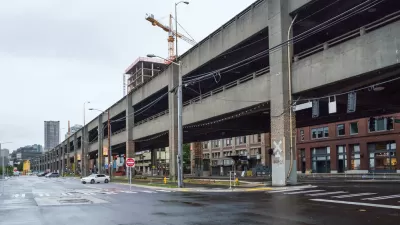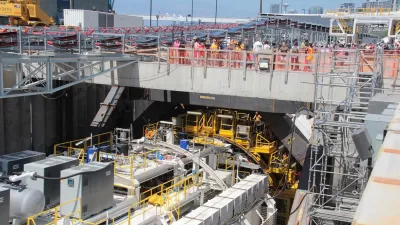With the Bertha tunneling-boring machine stuck in the mud under Seattle for more than a year, officials turned to a politician known for his ability to stop transportation in its tracks.
A surprising development in the behind-the-scenes saga of the massive tunnel-boring machine known as Bertha: anonymous sources inside the Washington State Department of Transportation have revealed that the agency briefly retained the services of New Jersey Governor Chris Christie to help jumpstart the stalled Alaskan Way Viaduct project in Seattle.
That is to say, Gov. Christie was brought on to try some old-fashioned reverse psychology. But don't call him a "tunnel-boring machine whisperer" just yet—sources say the technique didn't work.
"We thought, who better to make a convincing case to Bertha of its abject failure and inherent wastefulness than the same person who killed the most critical tunneling project in the country?" according to a state transportation official speaking on condition of anonymity, referring to Gov. Christie's infamous 2012 decision to kill the Trans-Hudson Passenger Rail Tunnel.
Sources close to the project say Gov. Christie communicated verbally with Bertha, describing the tunnel boring machine and all of its kind as poorly-conceived wastes of taxpayer money. There is no email or written record of Gov. Christie's involvement in the project, however.
Although reverse psychology failed, state transportation officials say the experiment showed that all options were on the table in trying to get Bertha moving again. "Duct tape" and/or "dumb luck" are currently given credit for Bertha's recent re-emergence from its subterranean meltdown.
FULL STORY: Chris Christie Hired to Try Reverse Psychology on Bertha Tunneling Project

Alabama: Trump Terminates Settlements for Black Communities Harmed By Raw Sewage
Trump deemed the landmark civil rights agreement “illegal DEI and environmental justice policy.”

Study: Maui’s Plan to Convert Vacation Rentals to Long-Term Housing Could Cause Nearly $1 Billion Economic Loss
The plan would reduce visitor accommodation by 25% resulting in 1,900 jobs lost.

Planetizen Federal Action Tracker
A weekly monitor of how Trump’s orders and actions are impacting planners and planning in America.

Wind Energy on the Rise Despite Federal Policy Reversal
The Trump administration is revoking federal support for renewable energy, but demand for new projects continues unabated.

Passengers Flock to Caltrain After Electrification
The new electric trains are running faster and more reliably, leading to strong ridership growth on the Bay Area rail system.

Texas Churches Rally Behind ‘Yes in God’s Back Yard’ Legislation
Religious leaders want the state to reduce zoning regulations to streamline leasing church-owned land to housing developers.
Urban Design for Planners 1: Software Tools
This six-course series explores essential urban design concepts using open source software and equips planners with the tools they need to participate fully in the urban design process.
Planning for Universal Design
Learn the tools for implementing Universal Design in planning regulations.
Caltrans
Smith Gee Studio
Institute for Housing and Urban Development Studies (IHS)
City of Grandview
Harvard GSD Executive Education
Toledo-Lucas County Plan Commissions
Salt Lake City
NYU Wagner Graduate School of Public Service




























